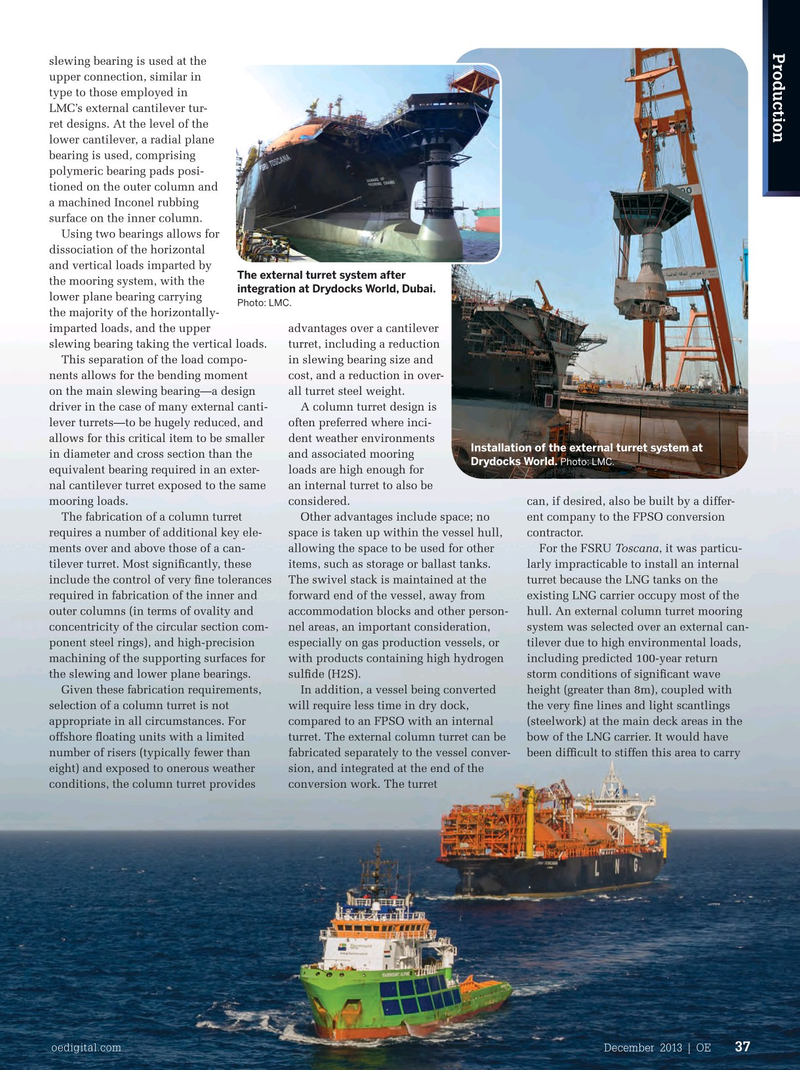
Page 35: of Offshore Engineer Magazine (Dec/Jan 2013)
Read this page in Pdf, Flash or Html5 edition of Dec/Jan 2013 Offshore Engineer Magazine
Production slewing bearing is used at the upper connection, similar in type to those employed in
LMC’s external cantilever tur- ret designs. At the level of the lower cantilever, a radial plane bearing is used, comprising polymeric bearing pads posi- tioned on the outer column and a machined Inconel rubbing surface on the inner column.
Using two bearings allows for dissociation of the horizontal and vertical loads imparted by
The external turret system after the mooring system, with the integration at Drydocks World, Dubai. lower plane bearing carrying
Photo: LMC.
the majority of the horizontally- imparted loads, and the upper advantages over a cantilever slewing bearing taking the vertical loads. turret, including a reduction
This separation of the load compo- in slewing bearing size and nents allows for the bending moment cost, and a reduction in over- on the main slewing bearing—a design all turret steel weight. driver in the case of many external canti- A column turret design is lever turrets—to be hugely reduced, and often preferred where inci- allows for this critical item to be smaller dent weather environments
Installation of the external turret system at in diameter and cross section than the and associated mooring
Drydocks World. Photo: LMC.
equivalent bearing required in an exter- loads are high enough for nal cantilever turret exposed to the same an internal turret to also be mooring loads. considered. can, if desired, also be built by a differ-
The fabrication of a column turret Other advantages include space; no ent company to the FPSO conversion requires a number of additional key ele- space is taken up within the vessel hull, contractor.
ments over and above those of a can- allowing the space to be used for other For the FSRU Toscana, it was particu- tilever turret. Most signifcantly, these items, such as storage or ballast tanks. larly impracticable to install an internal include the control of very fne tolerances The swivel stack is maintained at the turret because the LNG tanks on the required in fabrication of the inner and forward end of the vessel, away from existing LNG carrier occupy most of the outer columns (in terms of ovality and accommodation blocks and other person- hull. An external column turret mooring concentricity of the circular section com- nel areas, an important consideration, system was selected over an external can- ponent steel rings), and high-precision especially on gas production vessels, or tilever due to high environmental loads, machining of the supporting surfaces for with products containing high hydrogen including predicted 100-year return the slewing and lower plane bearings. sulfde (H2S). storm conditions of signifcant wave
Given these fabrication requirements, In addition, a vessel being converted height (greater than 8m), coupled with selection of a column turret is not will require less time in dry dock, the very fne lines and light scantlings appropriate in all circumstances. For compared to an FPSO with an internal (steelwork) at the main deck areas in the offshore foating units with a limited turret. The external column turret can be bow of the LNG carrier. It would have number of risers (typically fewer than fabricated separately to the vessel conver- been diffcult to stiffen this area to carry eight) and exposed to onerous weather sion, and integrated at the end of the conditions, the column turret provides conversion work. The turret oedigital.com December 2013 | OE 37 036_OE1213_ProdOps1-london marine.indd 37 11/22/13 6:22 PM

 34
34

 36
36